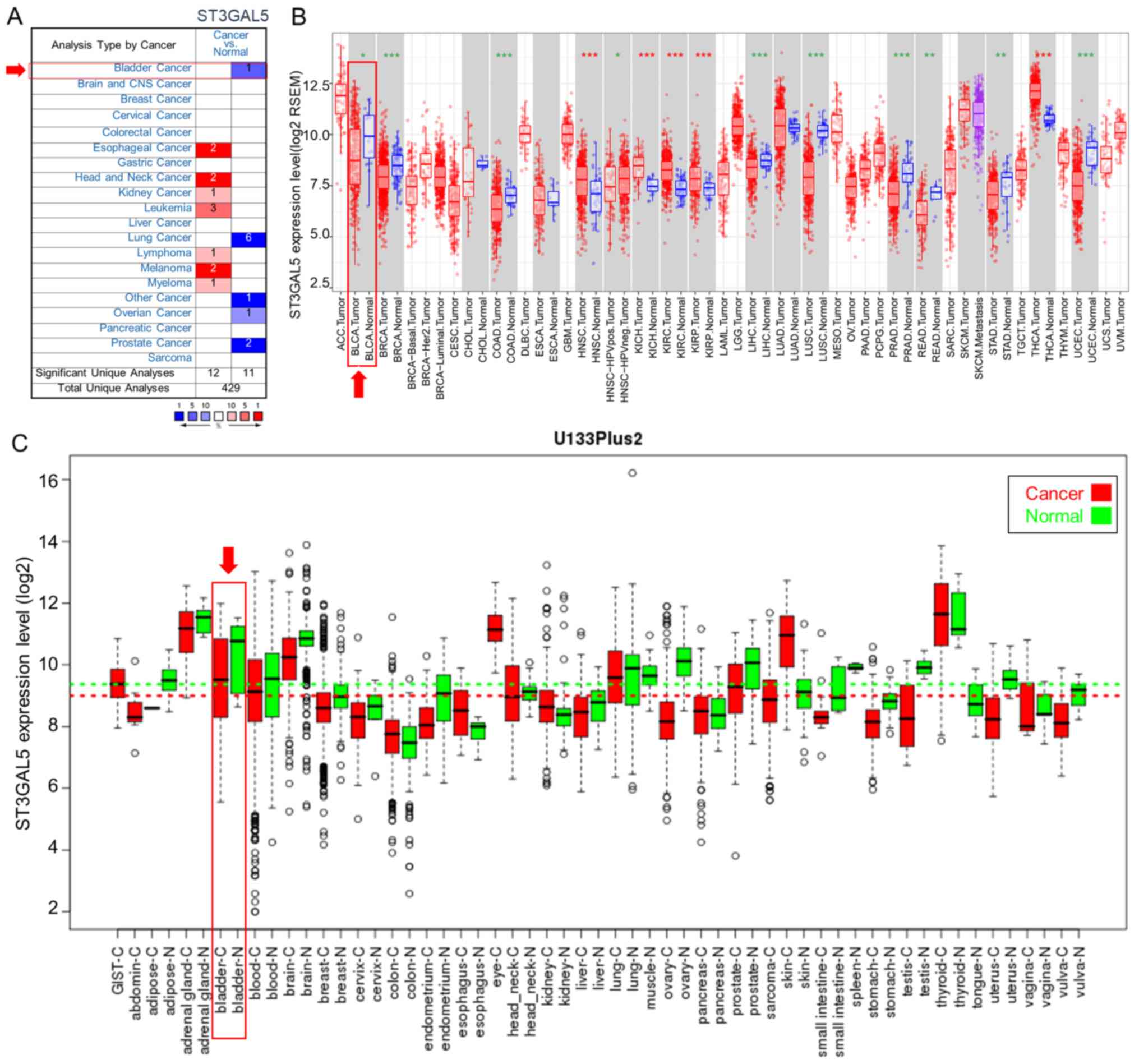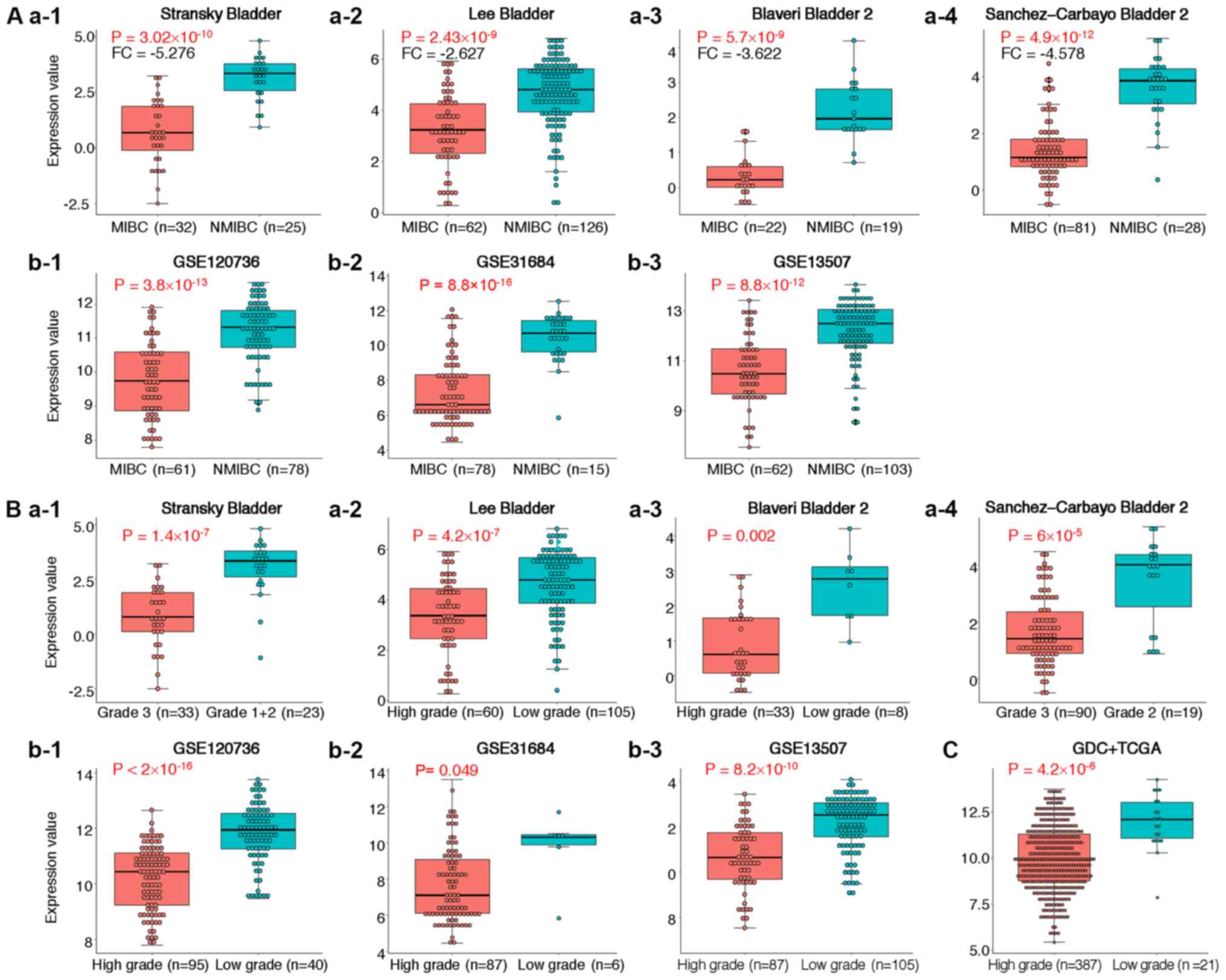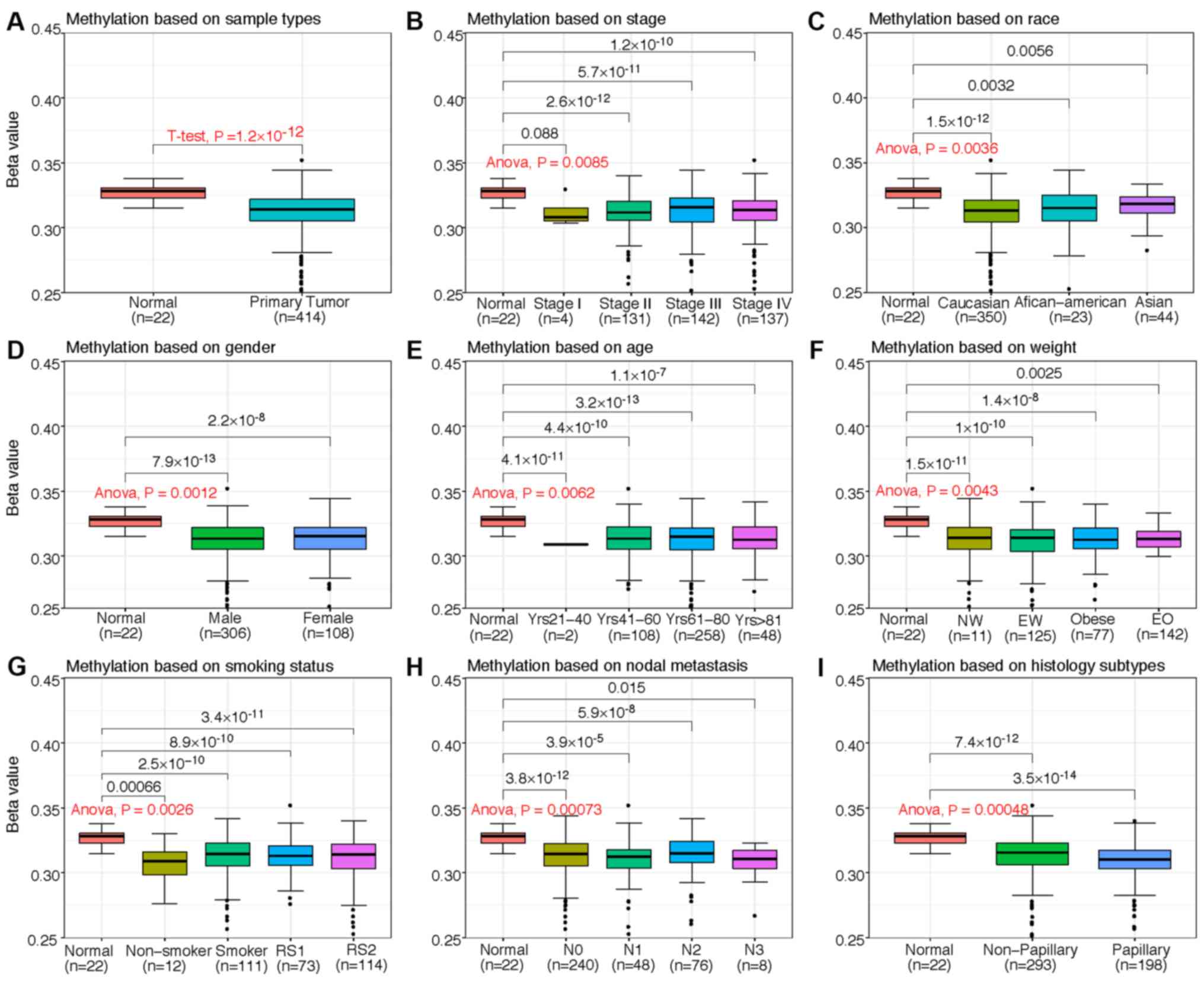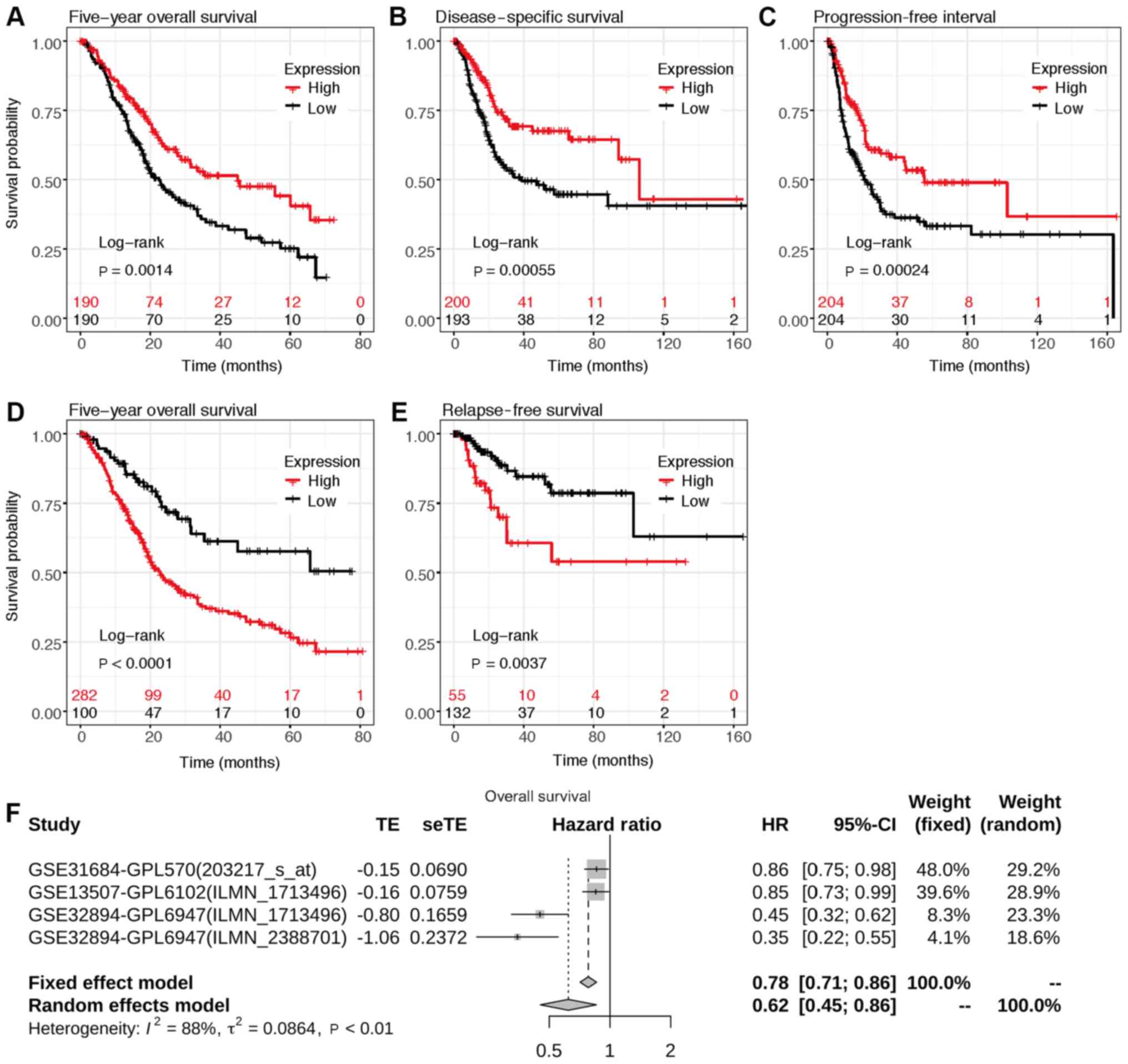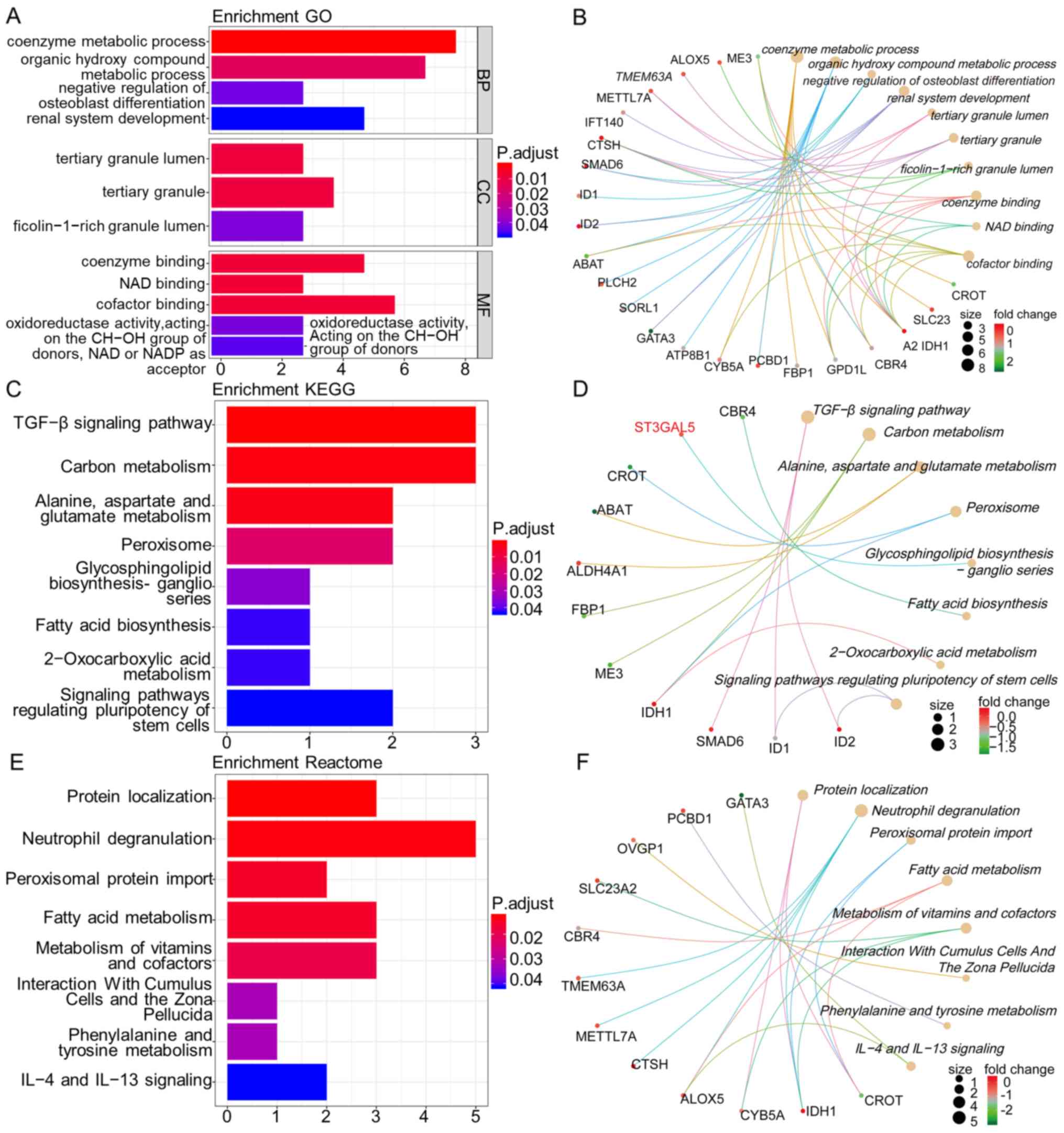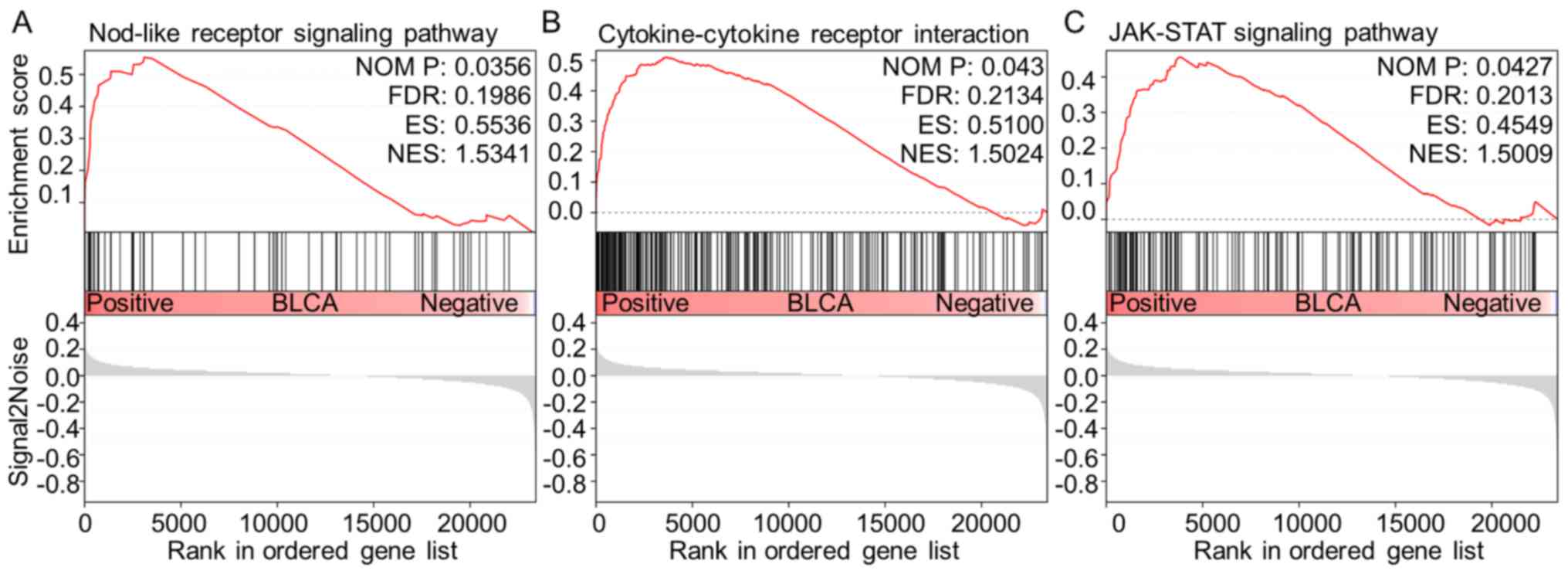|
1
|
Ferlay J, Colombet M, Soerjomataram I,
Dyba T, Randi G, Bettio M, Gavin A, Visser O and Bray F: Cancer
incidence and mortality patterns in Europe: Estimates for 40
countries and 25 major cancers in 2018. Eur J Cancer. 103:356–387.
2018. View Article : Google Scholar : PubMed/NCBI
|
|
2
|
GBD 2015 Disease and Injury Incidence and
Prevalence Collaborators, . Global, regional, and national
incidence, prevalence, and years lived with disability for 310
diseases and injuries, 1990–2015: A systematic analysis for the
Global Burden of Disease Study 2015. Lancet Lond Engl.
388:1545–1602. 2016. View Article : Google Scholar
|
|
3
|
Siegel RL, Miller KD and Jemal A: Cancer
statistics, 2019. CA Cancer J Clin. 69:7–34. 2019. View Article : Google Scholar : PubMed/NCBI
|
|
4
|
Burger M, Catto JW, Dalbagni G, Grossman
HB, Herr H, Karakiewicz P, Kassouf W, Kiemeney LA, Vecchia CL,
Shariat S and Lotan Y: Epidemiology and risk factors of urothelial
bladder cancer. Eur Urol. 63:234–241. 2012. View Article : Google Scholar : PubMed/NCBI
|
|
5
|
Miyazaki J and Nishiyama H: Epidemiology
of urothelial carcinoma. Int J Urol. 24:730–734. 2017. View Article : Google Scholar : PubMed/NCBI
|
|
6
|
Witjes JA, Lebret T, Compérat EM, Cowan
NC, De Santis M, Bruins HM, Hernández V, Espinós EL, Dunn J,
Rouanne M, et al: Updated 2016 EAU Guidelines on Muscle-invasive
and Metastatic Bladder Cancer. Eur Urol. 71:462–475. 2017.
View Article : Google Scholar : PubMed/NCBI
|
|
7
|
Berselli P, Zava S, Sottocornola E, Milani
S, Berra B and Colombo I: Human GM3 synthase: A new mRNA variant
encodes an NH2-terminal extended form of the protein. Biochimica
Biophysica Acta. 1759:348–358. 2006. View Article : Google Scholar
|
|
8
|
Inokuchi JI, Inamori KI, Kabayama K,
Nagafuku M, Uemura S, Go S, Suzuki A, Ohno I, Kanoh H and Shishido
F: Biology of GM3 Ganglioside. Prog Mol Biol Transl. 156:151–195.
2018. View Article : Google Scholar
|
|
9
|
Zheng C, Terreni M, Sollogoub M and Zhang
Y: Ganglioside GM3 and its role in cancer. Curr Med Chem.
26:2933–2947. 2019. View Article : Google Scholar : PubMed/NCBI
|
|
10
|
Hakomori SI and Handa K: GM3 and cancer.
Glycoconjugate J. 32:1–8. 2015. View Article : Google Scholar
|
|
11
|
Satoh M, Ito A, Nojiri H, Handa K,
Numahata K, Ohyama C, Saito S, Hoshi S and Hakomori SI: Enhanced
GM3 expression, associated with decreased invasiveness, is induced
by brefeldin A in bladder cancer cells. Int J Oncol. 19:723–731.
2001.PubMed/NCBI
|
|
12
|
Kawashima N, Nishimiya Y, Takahata S and
Nakayama KI: Induction of Glycosphingolipid GM3 expression by
valproic acid suppresses cancer cell growth. J Biol Chem.
291:21424–21433. 2016. View Article : Google Scholar : PubMed/NCBI
|
|
13
|
Ohyama C: Glycosylation in bladder cancer.
Int J Clin Oncol. 13:308–313. 2008. View Article : Google Scholar : PubMed/NCBI
|
|
14
|
Edgar R, Domrachev M and Lash AE: Gene
Expression Omnibus: NCBI gene expression and hybridization array
data repository. Nucleic Acids Res. 30:207–210. 2002. View Article : Google Scholar : PubMed/NCBI
|
|
15
|
Rhodes DR, Kalyana-Sundaram S, Mahavisno
V, Varambally R, Yu J, Briggs BB, Barrette TR, Anstet MJ,
Kincead-Beal C, Kulkarni P, et al: Oncomine 3.0: Genes, pathways,
and networks in a collection of 18,000 cancer gene expression
profiles. Neoplasia. 9:166–180. 2007. View Article : Google Scholar : PubMed/NCBI
|
|
16
|
Rhodes DR, Yu J, Shanker K, Deshpande N,
Varambally R, Ghosh D, Barrette T, Pander A and Chinnaiyan AM:
ONCOMINE: A cancer microarray database and integrated data-mining
platform. Neoplasia. 6:1–6. 2004. View Article : Google Scholar : PubMed/NCBI
|
|
17
|
Li B, Severson E, Pignon JC, Zhao H, Li T,
Novak J, Jiang P, Shen H, Aster JC, Rodig S, et al: Comprehensive
analyses of tumor immunity: Implications for cancer immunotherapy.
Genome Biol. 17:1742016. View Article : Google Scholar : PubMed/NCBI
|
|
18
|
Li T, Fan J, Wang B, Traugh N, Chen Q, Liu
JS, Li B and Liu XS: TIMER: A web server for comprehensive analysis
of tumor-infiltrating immune cells. Cancer Res. 77:e108–e110. 2017.
View Article : Google Scholar : PubMed/NCBI
|
|
19
|
Park SJ, Yoon BH, Kim SK and Kim SY:
GENT2: An updated gene expression database for normal and tumor
tissues. BMC Med Genomics. 12 (Suppl 5):1012019. View Article : Google Scholar : PubMed/NCBI
|
|
20
|
Shin G, Kang TW, Yang S, Baek SJ, Jeong YS
and Kim SY: GENT: Gene expression database of normal and tumor
tissues. Cancer Informatics. 10:149–157. 2011. View Article : Google Scholar : PubMed/NCBI
|
|
21
|
Goldman M, Craft B, Hastie M, Repečka K,
McDade F, Kamath A, Banerjee A, Luo Y, Rogers D, et al: The UCSC
Xena platform for public and private cancer genomics data
visualization and interpretation. Biorxiv 326470. 2019.
|
|
22
|
Tang Z, Li C, Kang B, Gao G, Li C and
Zhang Z: GEPIA: A web server for cancer and normal gene expression
profiling and interactive analyses. Nucleic Acids Res. 45:W98–W102.
2017. View Article : Google Scholar : PubMed/NCBI
|
|
23
|
Anaya J, Reon B, Chen WM, Bekiranov S and
Dutta A: A pan-cancer analysis of prognostic genes. Peer J.
3:e14992016. View Article : Google Scholar : PubMed/NCBI
|
|
24
|
Kim WJ, Kim EJ, Kim SK, Kim YJ, Ha YS,
Jeong P, Kim MJ, Yun SJ, Lee KM, Moon SK, et al: Predictive value
of progression-related gene classifier in primary non-muscle
invasive bladder cancer. Mol Cancer. 9:32010. View Article : Google Scholar : PubMed/NCBI
|
|
25
|
Riester M, Taylor JM, Feifer A, Koppie T,
Rosenberg JE, Downey RJ, Bochner BH and Michor F: Combination of a
novel gene expression signature with a clinical nomogram improves
the prediction of survival in high-risk bladder cancer. Clin Cancer
Res. 18:1323–1333. 2012. View Article : Google Scholar : PubMed/NCBI
|
|
26
|
Riester M, Werner L, Bellmunt J,
Selvarajah S, Guancial EA, Weir BA, Stack EC, Park RS, O'Brien R,
Schutz FA, et al: Integrative analysis of 1q23.3 copy-number gain
in metastatic urothelial carcinoma. Clin Cancer Res. 20:1873–1883.
2014. View Article : Google Scholar : PubMed/NCBI
|
|
27
|
Lee JS, Leem SH, Lee SY, Kim SC, Park ES,
Kim SB, Kim SK, Kim YJ, Kim WJ and Chu IS: Expression signature of
E2F1 and its associated genes predict superficial to invasive
progression of bladder tumors. J Clin Oncol. 28:2660–2667. 2010.
View Article : Google Scholar : PubMed/NCBI
|
|
28
|
Blaveri E, Simko JP, Korkola JE, Brewer
JL, Baehner F, Mehta K, Devries S, Koppie T, Pejavar S, Pejavar S,
et al: Bladder cancer outcome and subtype classification by gene
expression. Clin Cancer Res. 11:4044–4055. 2005. View Article : Google Scholar : PubMed/NCBI
|
|
29
|
Sanchez-Carbayo M, Socci ND, Lozano J,
Saint F and Cordon-Cardo C: Defining molecular profiles of poor
outcome in patients with invasive bladder cancer using
oligonucleotide microarrays. J Clin Oncol. 24:778–789. 2006.
View Article : Google Scholar : PubMed/NCBI
|
|
30
|
Stransky N, Vallot C, Reyal F,
Bernard-Pierrot I, de Medina SG, Segraves R, de Rycke Y, Elvin P,
Cassidy A, Spraggon C, et al: Regional copy number-independent
deregulation of transcription in cancer. Nat Genet. 38:1386–1396.
2006. View
Article : Google Scholar : PubMed/NCBI
|
|
31
|
Yu G, Wang LG, Han Y and He QY:
clusterProfiler: An R package for comparing biological themes among
gene clusters. OMICS. 16:284–287. 2012. View Article : Google Scholar : PubMed/NCBI
|
|
32
|
Yu G and He QY: ReactomePA: An
R/Bioconductor package for reactome pathway analysis and
visualization. Mol Biosyst. 12:477–479. 2016. View Article : Google Scholar : PubMed/NCBI
|
|
33
|
Sjödahl G, Eriksson P, Liedberg F and
Höglund M: Molecular classification of urothelial carcinoma: Global
mRNA classification versus tumour-cell phenotype classification. J
Pathology. 242:113–125. 2017. View Article : Google Scholar
|
|
34
|
Subramanian A, Tamayo P, Mootha VK,
Mukherjee S, Ebert BL, Gillette MA, Paulovich A, Pomeroy SL, Golub
TR, Lander ES and Mesirov JP: Gene set enrichment analysis: A
knowledge-based approach for interpreting genome-wide expression
profiles. Proc National Acad Sci. 102:15545–15550. 2005. View Article : Google Scholar
|
|
35
|
Villanueva RAM and Chen ZJ: ggplot2:
Elegant graphics for data analysis. (2nd). Meas Interdiscip Res
Perspectives. 17:160–167. 2019. View Article : Google Scholar
|
|
36
|
Nykopp TK, Batista da Costa J, Mannas M
and Black PC: Current clinical trials in non-muscle invasive
bladder cancer. Curr Urol Rep. 19:1012018. View Article : Google Scholar : PubMed/NCBI
|
|
37
|
Kaufman DS, Shipley WU and Feldman AS:
Bladder cancer. Lancet. 374:239–249. 2009. View Article : Google Scholar : PubMed/NCBI
|
|
38
|
Heijden AGvd and Witjes JA: Recurrence,
progression, and follow-up in non-muscle-invasive bladder cancer.
Eur Urol Suppl. 8:556–562. 2009. View Article : Google Scholar
|
|
39
|
Wang H, Isaji T, Satoh M, Li D, Arai Y and
Gu J: Antitumor effects of exogenous ganglioside GM3 on bladder
cancer in an orthotopic cancer model. Urology. 81:210.e211–215.
2012.
|
|
40
|
Li Q, Sun M, Yu M, Fu Q, Jiang H, Yu G and
Li G: Gangliosides profiling in serum of breast cancer patient: GM3
as a potential diagnostic biomarker. Glycoconjugate J. 36:419–428.
2019. View Article : Google Scholar
|
|
41
|
Guthmann MD, Castro MA, Cinat G, Venier C,
Koliren L, Bitton RJ, Vázquez AM and Fainboim L: Cellular and
humoral immune response to N-Glycolyl-GM3 elicited by prolonged
immunotherapy with an anti-idiotypic vaccine in High-Risk and
metastatic breast cancer patients. J Immunother. 29:215–223. 2006.
View Article : Google Scholar : PubMed/NCBI
|
|
42
|
Cai H, Zhou H, Miao Y, Li N, Zhao L and
Jia L: MiRNA expression profiles reveal the involvement of miR-26a,
miR-548l and miR-34a in hepatocellular carcinoma progression
through regulation of ST3GAL5. Lab Invest. 97:530–542. 2017.
View Article : Google Scholar : PubMed/NCBI
|
|
43
|
Kawamura S, Ohyama C, Watanabe R, Satoh M,
Saito S, Hoshi S, Gasa S and Orikasa S: Glycolipid composition in
bladder tumor: A crucial role of GM3 ganglioside in tumor invasion.
Int J Cancer. 94:343–347. 2001. View Article : Google Scholar : PubMed/NCBI
|
|
44
|
Chung TW, Choi HJ, Kim SJ, Kwak CH, Song
KH, Jin UH, Chang YC, Chang HW, Lee YC, Ha KT and Kim CH: The
ganglioside GM3 is associated with cisplatin-induced apoptosis in
human colon cancer cells. PLoS One. 9:e927862014. View Article : Google Scholar : PubMed/NCBI
|
|
45
|
Massagué J: TGFβ in Cancer. Cell.
134:215–230. 2008. View Article : Google Scholar : PubMed/NCBI
|
|
46
|
Colak S and Ten Dijke P: Targeting TGF-β
signaling in cancer. Trends Cancer. 3:56–71. 2017. View Article : Google Scholar : PubMed/NCBI
|
|
47
|
Newman AC and Maddocks ODK: One-carbon
metabolism in cancer. Brit J Cancer. 116:1499–1504. 2017.
View Article : Google Scholar : PubMed/NCBI
|
|
48
|
Moore LE, Malats N, Rothman N, Real FX,
Kogevinas M, Karami S, García-Closas R, Silverman D, Chanock S,
Welch R, et al: Polymorphisms in one-carbon metabolism and
trans-sulfuration pathway genes and susceptibility to bladder
cancer. Int J Cancer. 120:2452–2458. 2007. View Article : Google Scholar : PubMed/NCBI
|
|
49
|
Li X, Che K, Wang L, Zhang T, Wang G, Pang
Z, Shen H and Du J: Subcellular localization of β-arrestin1 and its
prognostic value in lung adenocarcinoma. Medicine. 96:e84502017.
View Article : Google Scholar : PubMed/NCBI
|
|
50
|
Liu J, Wang H, Huang C and Qian H:
Subcellular localization of MTA proteins in normal and cancer
cells. Cancer Metastasis Rev. 33:843–856. 2014. View Article : Google Scholar : PubMed/NCBI
|
|
51
|
Kim HJ, Lee SY, Kim CY, Kim YH, Ju W and
Kim SC: Subcellular localization of FOXO3a as a potential biomarker
of response to combined treatment with inhibitors of PI3K and
autophagy in PIK3CA-mutant cancer cells. Oncotarget. 8:6608–6622.
2017. View Article : Google Scholar : PubMed/NCBI
|
|
52
|
Boudhraa Z, Bouchon B, Viallard C, D'Incan
M and Degoul F: Annexin A1 localization and its relevance to
cancer. Clin Sci (Lond). 130:205–220. 2016. View Article : Google Scholar : PubMed/NCBI
|
|
53
|
Mollinedo F: Neutrophil degranulation,
plasticity, and cancer metastasis. Trends Immunol. 40:228–242.
2019. View Article : Google Scholar : PubMed/NCBI
|
|
54
|
Hanahan D and Weinberg Robert A: Hallmarks
of cancer: The next generation. Cell. 144:646–674. 2011. View Article : Google Scholar : PubMed/NCBI
|
|
55
|
Takeuchi H, Tanaka M, Tanaka A, Tsunemi A
and Yamamoto H: Predominance of M2-polarized macrophages in bladder
cancer affects angiogenesis, tumor grade and invasiveness. Oncol
Lett. 11:3403–3408. 2016. View Article : Google Scholar : PubMed/NCBI
|
|
56
|
Coffelt SB, Wellenstein MD and de Visser
KE: Neutrophils in cancer: Neutral no more. Nat Rev Cancer.
16:431–446. 2016. View Article : Google Scholar : PubMed/NCBI
|
|
57
|
Kent A and Blander JM: Nod-like receptors:
Key molecular switches in the conundrum of cancer. Front Immunol.
5:1852014. View Article : Google Scholar : PubMed/NCBI
|
|
58
|
Saxena M and Yeretssian G: NOD-like
receptors: Master regulators of inflammation and cancer. Front
Immunol. 5:3272014. View Article : Google Scholar : PubMed/NCBI
|
|
59
|
Ozaki K and Leonard WJ: Cytokine and
cytokine receptor pleiotropy and redundancy. J Biol Chem.
277:29355–29358. 2002. View Article : Google Scholar : PubMed/NCBI
|
|
60
|
Pencik J, Pham HTT, Schmoellerl J,
Javaheri T, Schlederer M, Culig Z, Merkel O, Moriggl R, Grebien F
and Kenner L: JAK-STAT signaling in cancer: From cytokines to
non-coding genome. Cytokine. 87:26–36. 2016. View Article : Google Scholar : PubMed/NCBI
|
|
61
|
Trivedi S and Starz-Gaiano M: Drosophila
Jak/STAT signaling: Regulation and relevance in human cancer and
metastasis. Int J Mol Sci. 19:40562018. View Article : Google Scholar
|















